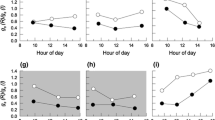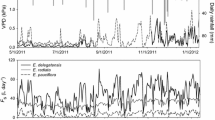Summary
The summer water use patterns of five species of Eucalyptus were examined in the Negev desert in Israel where they received trickle irrigation once every 10 days during the period July-August 1986. The species transpired between 8% and 16% of the irrigation input on I 1 (where I n is the number of days after irrigation), and between 54% to 64% at the end of the 10-day period. Evaporation from the soil surface was calculated to account for < 30% of the total evapotranspiration. Analysis of variance with repeated measurements indicated significant interspecific differences in the mean hourly transpiration rates through the 10-day period after irrigation. Eucalyptus grossa, E. salubris, E. torquata and E. woodwardii had a pattern of initially high transpiration rates ranging from 126 to 70 mg cm−2 d−1 on I 1, and gradually decreasing rates that stabilized at near constant rates ranging from 38 to 17 mg cm−2 d−1 after I 3. Intraspecihc analyses of variance indicated that the transpiration rates of these four species were significantly different on the successive days after irrigation, while the transpiration rates of E. socialis were much more constant ranging only from 53 to 23 mg cm−2 d−1 over the 10-day period. The rapid depletion of irrigation inputs by E. grossa, E. salubris, E. torquata and E. woodwardii may be explained as an adaptation to the summer climatic conditions in their respective provenances in southwestern Western Australia. Under natural conditions, high transpiration rates are a means of exposing competitors to more severe soil water deficits. E. socialis, whose seed provenance was in Central Australia where summer rainfall is greater, did not exhibit the same water-spending strategy. The persistence of water use patterns that correspond to the climatic conditions in the provenances of drought-adapted ucalypts is an important consideration when selecting suitable species for trickle-irrigated afforestation projects in dryland environments.
Similar content being viewed by others
References
Basawa IV, Billard L, Srinivasan R (1984) Large-sample tests of homogeneity of time series models. Biometrika 71:203
Ben-Asher J, Sammis TW (1978) Radiation and energy balance of a trickle-irrigated lemon grove. Agron J 70:568
Bidner-Barhava N, Ramati B (1967) The tolerance of some species of Eucalyptus, Pinus and other forest trees to soil salinity and low soil moisture in the Negev. Israel J Agric Res 17:65
Blake ST (1953) Botanical contributions of the northern Australia regional survey. I. Studies on northern Australian species of Eucalyptus. Aust J Bot 1:185
Box GEP, Jenkins GM (1970) Time series analysis: forecasting and control. Holden-Day, San Francisco
Bunce JA, Miller LN, Chabot BF (1977) Competitive exploitation of soil water by five eastern North American tree species. Bot Gaz 138:168
Chamshama SAO, Hall JB (1987) Effects of site preparation and fertilizer application at planting on Eucalyptus tereticornis at Morogoro, Tanzania. Forest Ecol Manag 18:103
Collatz J, Ferrar PJ, Slatyer RO (1976) Effects of water stress and differential hardening treatments on photosynthetic characteristics of a xeromorphic shrub, Eucalyptus socialis, F. Muell. Oecologia 23:95
Dan J, Moshe R, Alperovitch N (1973) The soils of Sede Zim. Israel J Earth Sci 22:211
Doley D (1967) Water relations of Eucalyptus marginata Sm. under natural conditions. J Ecol 55:597
Evenari M, Shanan L, Tadmor NH (1968) Runoff farming in the desert. I. Experimental layout. Agron J 60:29
Greenwood EAN, Beresford JD (1979) Evaporation from vegetation in landscapes developing secondary salinity using the ventilated-chamber technique. I. Comparative transpiration from juvenile Eucalyptus above saline groundwater seeps. J Hydrol 42:369
Grieve BJ, Hellmuth EO (1970) Eco-physiology of Western Australian plants. Oecol Plant 5:33
Goudriaan J (1977) Crop micrometeorology: a simulation study. Centre for Agricultural Publishing and Documentation, Wageningen, The Netherlands
Hall N, Wainwright RW, Wolf LJ (1981) Summary of meteorological data in Australia. CSIRO Forest Research Divisional Report No. 6
Herwitz SR, Yair A, Shachak M (1988) Water use patterns of introduced carob trees (Ceratonia siliqua L.) on rocky hillslopes in the Negev desert. J Arid Environ 14:83
LI-COR Inc. (1984) LI-1600 Steady State Porometer. User's Group Newsletter, Vol 1, No 1
Nobel PS, Jordan PW (1983) Transpiration stream of desert species: resistances and capacitances for a C3, a C4, and a CAM plant. J Exp Bot 34:1379
Pereira JS, Kozlowski TT (1976) Leaf anatomy and water relations of Eucalyptus camaldulensis and E. globulus seedlings. Can J Bot 54:2868
Pryor LD (1976) The biology of eucalypts. Institute of Biology's Studies in Biology No. 61, Edward Arnold, London
Pryor LD, Johnson LAS (1981) Eucalyptus, the universal Australian. In: Keast A (ed) Ecological biogeography of Australia. Junk, The Hague, pp. 501–536
Quraishi MA, Kramer PJ (1970) Water stress in three species of Eucalyptus. Forest Sci 16:74
Sandell R, Kube P, Chuk M (1986) Dryland tree establishment in Central Australia. Forest Ecol Manag 16:411
Schulze ED, Cermak J, Matyssek R, Penka M, Zimmerman R, Vasicek F, Gries W, Kucera J (1985) Canopy transpiration and water fluxes in the xylem of the trunk of Larix and Picea trees — a comparison of xylem flow, porometer and cuvette measurements. Oecologia 66:475
Stibbe E (1975) Soil moisture depletion in summer by an eucalyptus grove in a desert area. Agro-Ecosystems 2:117
Yaalon DH, Dan J (1974) Accumulation and distribution of loess-derived deposits in the semidesert and desert fringe areas of Israel. Z Geomorphol (Suppl) 20:91
Zangvil A, Druian P (1983) Meteorological data for Sede Boqer. Desert Meteorology Papers, Series A, No. 8, Blaustein Institute for Desert Research, Sede Boqer, Israel
Zohar Y (1982) Growth of Eucalyptus on saline soils in the Wadi Arava. La-Yaaran 32:60
Author information
Authors and Affiliations
Rights and permissions
About this article
Cite this article
Herwitz, S.R., Gutterman, Y. & Srinivasan, R. Comparative transpiration of irrigated juvenile eucalypts in the Negev desert. Irrig Sci 9, 233–247 (1988). https://doi.org/10.1007/BF00275435
Received:
Issue Date:
DOI: https://doi.org/10.1007/BF00275435




